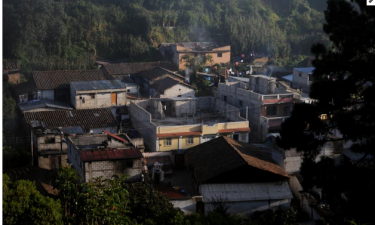This post is part of our special coverage Indigenous Rights.
At least 7 civilians were killed, up to 32 were injured, and 35 were intoxicated on October 4, 2012, when combined armed forces violently removed demonstrators from Cuatro Caminos (“four roads”), a well-known intersection of roads that go to Quetzaltenango, Guatemala City, Huehuetenango and Totonicapán.
Demonstrators blocked the road to protest the rising price of electricity in the area. They also demand a dialogue with the government to discuss their objections to the education and constitutional reforms proposed by President Otto Pérez Molina.
The demonstrators were representatives from indigenous communities from Totonicapan, an exceptional, mostly indigenous (90%) community in the Guatemalan highlands.
While demonstrations are common in the area, the number of persons killed and injured is highly unusual. There is evidence that members of the Guatemalan Army were carrying guns, although the Minister of Interior has denied it, arguing that the peasants killed each other, as Mario Rodríguez explains in his blog post “Declarations full of cynicism” [es].

Cantons in Totonicapán. Photo by Sandra Sebastian from plazapublica.com.gt under a Creative Commons Attribution Non-Commercial license.
Totonicapán is one of the best organized and least violent [es] areas in the country, in spite of extreme poverty with up to 82.2% [es] of malnourished people. Hard working and one of the most active environmentalist communities, the people in Totonicapán are dedicated to preserving the forest and their water sources, as described by Cultural Survival:
The forest has been preserved for generations, thanks to the work of people who have lived in harmony with the world around them, by means of ancestral knowledge of resource management and active participation of each community.
For such level of care and management you need a well-organized community and active leaders seeking common good. Totonicapán is one of the few territories where indigenous authorities exercise power, divided in 48 cantons, lead by community mayors and a President who serves as the mediator in case of conflicts and as the spokesperson when it is necessary to dialogue beyond the community.
In 2011, for the first time in history, a single woman, law student María del Carmen Tacam, was elected President of the Cantons in Totonicapán. She explained in an interview [es] that she follows the instructions of the consensus of all 48 local authorities.
As reported by Voces Mayas [es], María del Carmen explained that while appealing to refrain from violent measures, the indigenous communities blocked the Cuatro Caminos intersection because the government and the corporations did not respond to their clear demands. She also mentioned that the local hospital collapsed due to the number of people injured.
In her declarations, María del Carmen explained [es] to the press that the community of Totonicapán demanded a dialogue to find solutions to three sensitive issues:
- The Constitutional Reform proposed by the President, which they disapprove.
- Education reform, as they oppose the modifications to the requirements to become a school teacher.
- Rising cost of electricity because the company did not stick to their commitments.
The community wants to keep the dialogue open and is waiting for clear responses from the government of Pérez Molina. During the previous government, the dialogue between the government and the communities was mediated by the Ombudsman, as documents [es] show, but this time he was denied access.

María del Carmen Tacám and the symbol of power. Photo by Sandra Sebastian from plazapublica.com.gt under a Creative Commons Attribution Non-Commercial license.
Furthermore, as early as March 2012, different voices raised their concerns about the rapidly growing size and role of the military in Guatemala and the presence of so-called “mega projects” like the Goldcorp mine. Cascadia solidaria comments about the increased militarized actions against civilians:
The strategic use of roadblocks by indigenous and campesino organizations as form of political pressure and re-vindication is harshly contested by the state and powerful economic actors, especially the business lobby CACIF*, which has campaigned for the prohibition and repression of blockades as violations of the right to freedom of movement. The Pérez Molina administration has previously used violence to break up roadblocks and occupations by students, teachers, and parents protesting exclusionary education reforms; if today’s deaths are confirmed to be the responsibility of security forces, it will mark the first clear instance of mortal government repression against civilian protest under Mano Dura. While community leaders have called for investigation of the deaths, if the administration follows the blueprint established by its response to social conflict and protest in Barillas, Huehuetenango, repressive measures such as arrests of protest leaders or declaration of a state of exception could be implemented instead.
In an official statement, the President –who is the maximum authority and Commander in Chief of the Guatemalan Army– indicated that he has ordered an investigation [es] into the violence and deaths from October 4.
In the meantime, the communities are waiting for dialogue and responses.
This post is part of our special coverage Indigenous Rights.







10 comments
Very sorry to hear of this violence and terrible loss of life. People in positions of power in all areas around the world would be wise to negotiate in peace with the suffering people so that we all can survive as brothers and sisters on Mother Earth. We only have one planet and we should be more compassionate and considerate of each other and Mother Earth. Peace and hugs and civil liberties and life for all.
horrible, yo trabaje en este lugar en los 80’s bonito lugar increible la gente y bonito telas es muy mal noticias, ellos involcrado necisita a ir a justicia pero si hay dos lados de todos historias
Please take action to denounce the massacre in Totonicapán. Sign our petition demanding justice!
http://salsa.democracyinaction.org/o/2690/p/dia/action/public/?action_KEY=11745